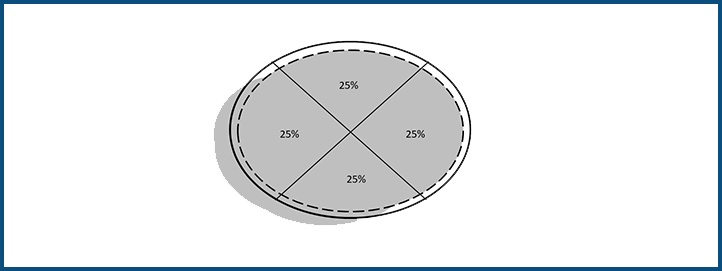Medical providers and their patients alike are commonly confused on the difference between a disc bulge and a disc herniation. We’re going to discuss important distinguishing factors and why it’s critical to be able to tell the difference in the injured patient.
Disc bulges
Disc bulges are normal findings in normal people. They represent a subset of degeneration that occurs normally with aging. Since it is a normal age-related change it does not cause pain.
When a disc degenerates from normal aging it degenerates diffusely. The disc starts to bulge beyond the borders of the vertebral body (the normal boundary point for the disc). Sometimes, as the disc bulges past the vertebral body, it pulls bone along with it. This causes osteophytes, or bony spurs.
Disc herniations
Disc herniations are characterized as a subtype of degeneration caused by injury. While a bulge is part of a normal process, a disc herniation is not. Disc herniations are injuries. Disc herniations are associated with pain, at one time or another. Disc herniations are always abnormal.
When a disc is injured, a focal radially oriented tear extends from the center of the disc to the periphery. Disc material from the disc center enters this tear, causing a herniation. The herniation will cause a focal (25% or less) protuberance of the disc beyond the vertebral body margin. This focal protuberance is called a protrusion or herniation.
Telling bulges from herniations: The guidelines
There are rather strict guidelines that have been developed by medical spinal societies to aid radiologists in distinguishing a disc bulge from a disc herniation. This determination is made by looking at axial slices of the disc (the view where the MRI image is slicing across the horizontal disc axis). On these images the disc is divided up into 4 slices of pie. Each slice represents 25% of the disc circumference. Since a disc herniation is a focal disc injury, the area of the disc where the disc protuberance extends beyond the vertebral bony margin is expected to occupy 25% or less of the disc circumference (less than 1 pie slice (figure 1)).
Figure 1
When disc material (shaded) extends beyond its normal margin (dashed line) and the normal vertebra margin (solid line), but involves less than 25% of the disc circumference a herniation is present. This type of herniation is called a protrusion.
Since a disc bulge is a degenerative process, it is expected to be diffuse. On MRI the area of the disc where the disc protuberance extends beyond the vertebral bony margin is greater than 25% of the disc margin (greater than 1 pie slice (figure 2)).
Figure 2
When the disc material protrudes beyond greater than 25% of the disc circumference experts call it a disc bulge.
Why is telling the difference important?
There are important clinical distinctions between a disc bulge and a disc herniation. Disc bulges should not undergo treatment. On the other hand, symptomatic disc herniation patients will go untreated if they have wrongly been diagnosed with a disc bulge. Lack of treatment will result in continued or recurrent symptoms. Proper interpretation of the MRI and correlation with the patient’s symptoms are key to making the correct diagnosis and assigning the appropriate prognosis.
Conclusion
The proper distinction between a disc bulge and a disc herniation is of critical importance in a personal injury case. Often defense experts will dismiss a herniation as a bulge to characterize it as a normal and degenerative finding. Understanding the distinctions on MRI will allow a proper diagnosis, treatment recommendations and prognosis.
Edward George Armstrong, MD
The views expressed are the personal views of the author and do not represent the views of The Brain, Spine and Joint Group, its managers, affiliates, partners, employees or its clients. Furthermore, the information provided by the author is not intended to be expert or legal advice.
The content of this newsletter is confidential. It is strictly forbidden to copy, forward, reveal the content of or share any part of this newsletter content with any third party, without a written consent of The Brain, Spine and Joint Group. If you received this newsletter, or a link to it, by mistake, please message


